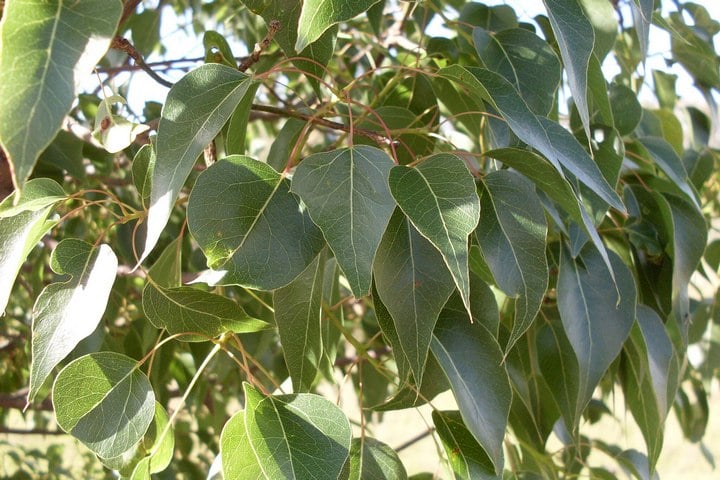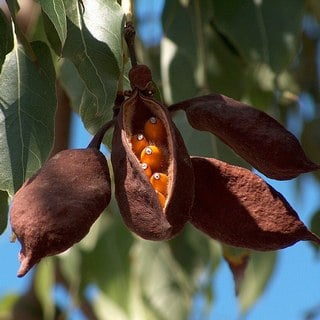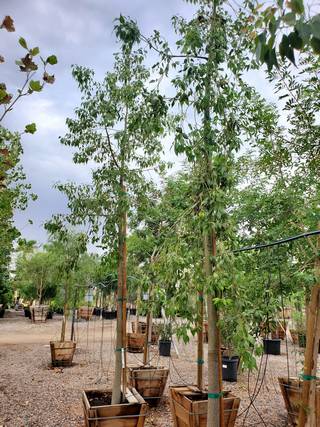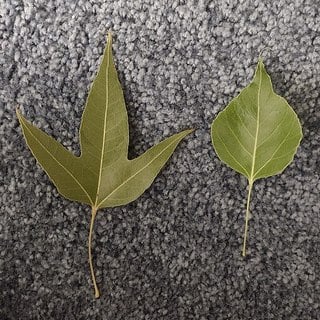Bottle tree is a unique tree that you can identify by simply looking at its trunk. Unlike most desert trees, it grows bean-pole straight and narrow. Here’s how to plant and care for this evergreen Australian native.

The first thing you may notice about bottle tree (Brachychiton populneus) is that it looks unlike other trees grown in desert landscapes.
Bottle tree has a straight, single trunk and the overall shape is vertical rather than wide. Its tapering trunk flares at the base, enabling it to store water during drought.
It has elongated evergreen leaves reminiscent of poplar leaves. When in bloom, it’s covered with clusters of charming, bell-shaped flowers that are creamy white on the outside and reddish-brown on the inside.
It blooms in late spring to early summer. Flowers are followed by clusters of woody pods that contain seeds that look like corn kernels.
Why I Like This Plant
- Unusual trunk, strongly upright form
- Charming bell-shaped flowers
- Interesting seed pods
- Low maintenance

Things to Watch Out For
If woodpeckers frequent your yard, be aware that they love to peck holes in bottle tree’s smooth bark.
This is not a low-litter tree. It sheds flowers and woody seed pods that do not readily disintegrate, so be prepared to do some clean up.

The seed pods contain hairs that some people find irritating.
When overwatered, bottle tree is highly susceptible to Texas root rot, a soil-borne fungus that is inevitably fatal.
Don’t plant this near sewer lines, since its roots can damage underground pipes.
If you prefer plants that support wildlife, note that this tree seems to have little-to-no value to native wildlife.
Optimal Growing Conditions
If you’re thinking of adding a bottle tree to your garden, you need to find a suitable place that will keep your tree healthy and looking good… while minimizing maintenance for you.
Here are the key factors to keep in mind.
Temperature
Bottle tree should be grown in USDA Hardiness Zones 8 – 11. It withstands desert heat and survives cold down to 20℉.
Sun Exposure
Bottle tree should be planted in full sun, but watch out for those west-facing locations. Too much hot western sun can scald the trunk.
In the hottest areas like Phoenix, it may suffer from heat stress when surrounded by buildings, boulders, or gravel mulch.
Size and Growth Rate
Bottle tree is a fast grower that starts out narrow, but eventually spreads with age. It typically reaches a mature size of 35 feet tall by 20 feet wide in desert landscapes. However, it can grow much taller — up to 60 feet!
Soil
In its native habitat, bottle tree can be found growing in rocky outcrops. It grows well in any kind of desert soil, provided it’s well-draining.
Bottle Tree:
The Essentials
| Common Name | Bottle tree |
| Scientific Name | Brachychiton populneus |
| Origin | Eastern Australia |
| Plant Type | Evergreen tree |
| USDA Zones | Zones 8 – 11 |
| Cold Hardiness | To 20℉ |
| Flower Color | Cream & brown |
| Flower Season | Spring, summer |
| Mature Size | 35’ high x 20’ wide |
| Growth Rate | Fast |
| Sun Tolerance | Full sun |
| Water Needs | Low |
| Pests & Diseases | Root rot |
| Cautions | Contact irritation |
| Wildlife | None |
How to Plant
The rule of thumb when planting any tree in the desert is to dig a hole three times as wide as the root ball but no deeper. As tempting as it is to add amended soil, this is not recommended. Counterintuitively, backfilling with only native soil helps your plant develop a better root system.
Bottle trees typically look like bean poles when you buy them — tall, straight, and slender.

When to Plant
The best time to plant bottle tree is in the fall. This gives your tree three seasons to grow roots and get established before the following summer.
The second best time is in spring, the earlier the better. This still gives your plant time to get established before the intense heat of June arrives.
How to Care for Bottle Tree
Whether you’ve recently planted a new bottle tree or have an existing one in your yard, here’s how to take care of it to keep it healthy and looking its best.
How to Water New Plants
Once you’ve got your bottle tree in the ground, watering is your most immediate concern. Here is the recommended watering schedule for new trees planted in the spring or fall.
| Weeks 1 & 2 | Every 3 – 4 days |
| Weeks 3 & 4 | Every 6 – 7 days |
| Weeks 5 & 6 | Every 7 – 10 days |
How to Water Established Plants
As your tree becomes established, there are two watering factors to consider.
- First is how often to water. This will vary with the seasons.
- Second is how much water to give your tree with each watering. This depends on its current size.
To determine the ideal watering schedule for any desert tree, you’ll find everything you need to know, including easy-to-use charts, at How to Water Desert Trees: How Often? How Much?
Should You Fertilize?
Bottle tree is a fast-growing, resilient tree that doesn’t need fertilizer.
How to Prune
Bottle tree naturally grows as a single trunk tree and needs little pruning to keep its shape.
It’s recommended that you leave lower branches on newly planted trees to protect the trunk from sun scald.
Plant Lover Facts
Bottle tree is native to eastern Australia. This tree can have two distinct leaf shapes, depending on the subspecies.
Brachychiton populneus spp. trilobus has leaves with 3 or 5 narrow lobes. Ir mainly grows in the desert and dry shrublands. Brachychiton populneus spp. populneus has elongated leaves with no lobes. It primarily grows in the subtropics. Most landscape plants sold in the US have the poplar-like leaves pictured on the right.

Bottle tree also goes by the names Australian bottle tree and kurrajong. The name kurrajong means “fishing line” since the bark of the tree was traditionally used by the Koori people to make fibers for baskets, fishing lines and nets and other woven goods. They also roasted and ate the seeds. Roasted seeds can also be ground and used as a coffee substitute.
Did you enjoy this article?
Sign up for our weekly newsletter
where you’ll find more great info on creating &
maintaining a beautiful, carefree desert landscape.
Author Bio
Deane Alban is the creator of Southwest Gardener. She is a science writer with a bachelor’s degree in botany from the University of South Florida. Gardening is her lifelong passion. She’s been gardening in Tucson for over 15 years.

Photo Credits
John Tann, CC BY-SA 2.0, Wikimedia Commons
Philmarin, CC BY-SA 3.0, Wikimedia Commons
Philmarin, CC BY-SA 3.0, Wikimedia Commons
Flavorcup, CC BY-SA 4.0, Wikimedia Commons
